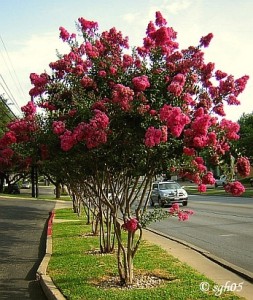San Antonio Express News
GARDENING, Etc.
Sunday, September 4, 2005
 What is the most versatile plant in the Texas landscape? The one which flowers all summer, is available in different colors, has beautiful bark, has different shapes and sizes from groundcover to shrub to tree, is drought tolerant after it is well established (approximately two years), grows well in alkaline or acid soil, is a fast-growing plant with a long life span, is disease resistant and the foliage displays fall color? The answer has to be crape myrtle.
What is the most versatile plant in the Texas landscape? The one which flowers all summer, is available in different colors, has beautiful bark, has different shapes and sizes from groundcover to shrub to tree, is drought tolerant after it is well established (approximately two years), grows well in alkaline or acid soil, is a fast-growing plant with a long life span, is disease resistant and the foliage displays fall color? The answer has to be crape myrtle.
Crape myrtle (Lagerstroemia species) is a handsome, summer flowering, deciduous (loses its leaves) tree-shrub-groundcover. It has been called the lilac of the south. The most common species in the United States is Lagerstroemia indica. It is native to China and Korea, but is naturalized in the Southern U.S. L. fauriei, native to Japan, is another species found in the United States. Hybrids of the two species generally result in excellent selections as pictured and described at: http://aggie horticulture.tamu.edu/plantanswers/trees/crapemyrtle/crape_myrtle_varieties.html
The crape myrtle is valued mainly for its long period of striking summer flowers. These showy flowers may be shades of white, pink, red or lavender. Bloom time varies, depending on the variety. Large clusters appear on the tips of new branches beginning in early summer and continue into fall. After flowers fade and fall from the tree, the fruit (small brown capsules) can be cut from the plant to stimulate more bloom in 30-45 days. Fruit capsules should not be removed after September.
The attractive, exfoliating bark peels away to expose a trunk which ranges in color from many handsome shades of brown to gray. This bark is especially noticeable in the winter months when the tree is leafless.
Fall leaf color ranges from yellow to orange and red. Although the same plant may display leaves of several colors, the white flowered types often have yellow fall color, and the pink and red flowered types show yellow, orange and red leaf color in the fall.
The crape myrtle can be planted as a specimen or in groups, and looks attractive when underplanted with a ground cover; the dark green of the groundcover contrasts well with the handsome bark. It adapts well to confined spaces, and is, therefore, well suited for small areas close to sidewalks or parking lots, and can provide shade in deck and patio areas.
The plant typically develops several main stems. These multi trunk crape myrtles are more desirable than single stem plants in landscape plantings.
Crape myrtle can be a low maintenance plant, and the best way to ensure this is to choose the cultivar that best suits your landscape needs before planting. There are many new cultivars in different sizes and colors. The dwarf (3 to 6 feet) and semi dwarf (7 to 15 feet) selections now available make it easy to choose the right size plant for a certain space.
The flowers of some selections may stain car paint, and the honeydew drops from aphids on the plant may stick on cars or patio furniture. As cultivars are now available in a wide range of growth heights, certain selections can be used under utility lines without fear of interfering with these lines.
The ideal planting site is in well prepared, well drained soil, with full sun exposure and good air circulation. Crape myrtles planted in partial or full shade will have reduced flowering and increased disease susceptibility.
Heavy nitrogen applications cause the plants to flower less and produce shoot and leaf growth that may be subject to winter injury. Light applications of a complete, slow-release fertilizer such as 19-5-9 in early spring should be made just before new growth begins. A general recommendation of 2 pounds (two cupfuls) of the slow-release fertilizer per 1,000 square feet of root area is sufficient for most trees and shrubs. This can be repeated again in the late fall. The number of square feet in the root area is determined by the branch spread of the tree.
For a discussion of pruning old and young trees as well as pest problems which can be encountered, see the second column in September entitled: CRAPEMYRTLE – THE BEST LANDSCAPE PLANT FOR TEXAS at: http://www.plantanswers.com/garden_columns.htm
Dr. Jerry Parsons is a Professor for Texas A&M University and a Texas Cooperative Extension Horticulturist for over 30 years in South Central Texas. For more information on this or other horticulture topics, go to www.plantanswers.com and our County Extension website at http://bexar-tx.tamu.edu.